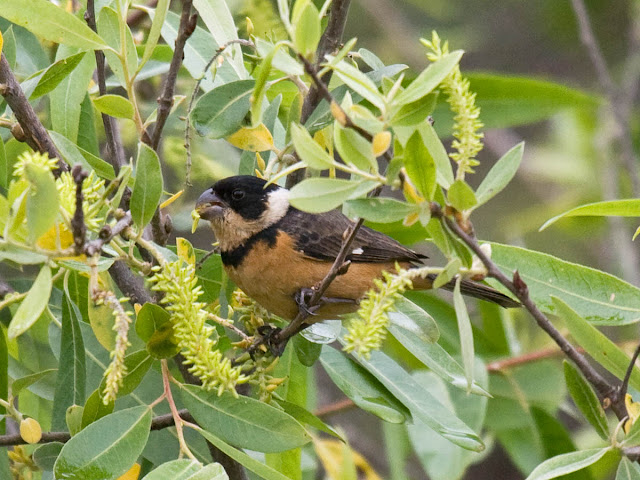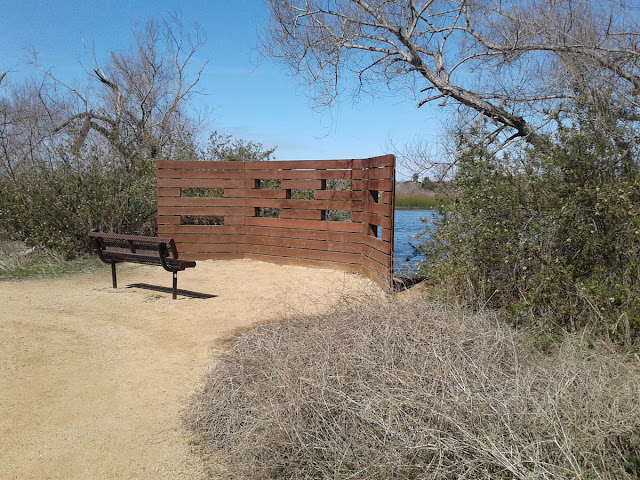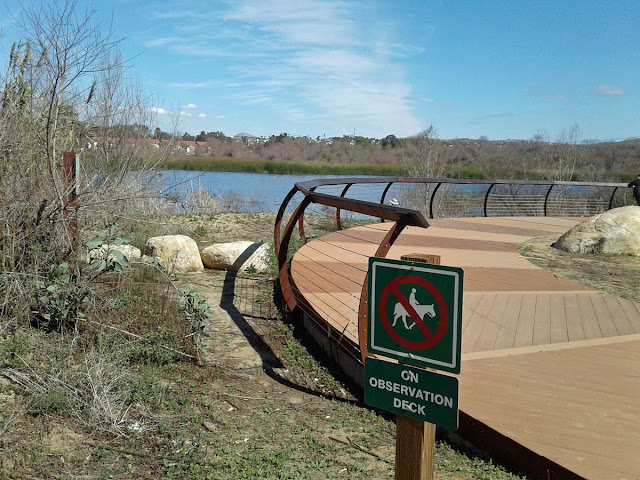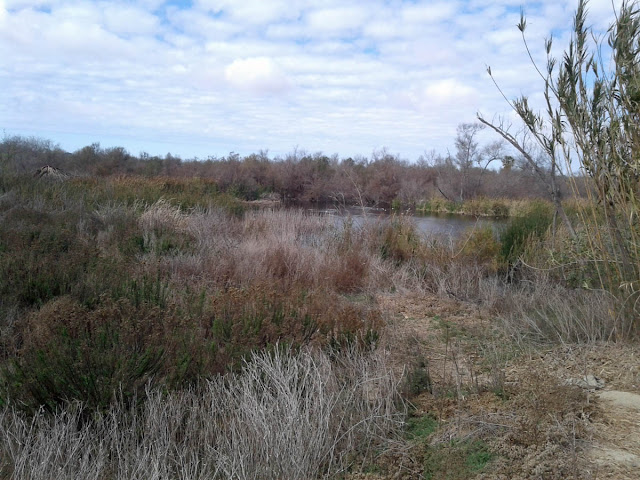The river bottom is heavily vegetated with willows, bamboo, coyote bush, and other plants. This is a popular area with hikers, bikers, and horse riders. And it is heavily patrolled by border guards. Use caution and buddy up, but don't be overly concerned for your safety. Sadly, that advice is pretty much universal for the entire world, these days.
There are many birding hotspots in the Tijuana River Valley--especially in winter when some migrants that normally winter in southern Mexico may be found (orioles, tanagers, grosbeaks, warblers, flycatchers). One also has to be aware that nearly any Mexican bird may be found as escapees from the pet trade in nearby Tijuana (Cinnamon-rumped Seedeaters, Black-throated Magpie-Jays, and Northern Cardinals have small stable populations, and any parrot is possible).
This site guide covers the Dairy Mart Ponds, perhaps the first stop for birders visiting this area. The ponds are old sand pits, filled with water, edged heavily with willows, and returned to nature.
Two of my site guides to nearby areas:
Tijuana River mouth--Seacoast Drive
Bird & Butterfly Garden
Getting There: Take I-5 south 14 miles from the I-15 interchange in San Diego to Exit 2, Dairy Mart Road. Turn south (right) and turn into the dirt parking lot after 0.2 miles. Parking: Free. Hours: Daylight. Map Navigation: 2564 Dairy Mart Rd., San Ysidro, California.
Where to Bird: Most birders park near the northern Main Pond (A on map below), walk west on the trail, and view the pond from a couple of vantage points. Then they walk back to their cars, drive south to the second parking area and view the Stick Pond (B) and the South Pond (C). This is a quick stop if your goal is to visit many more of the good birding spots in the Tijuana River Valley. Such a quick stop can be just 30 minutes at each of the two parking areas.
But I like to walk the entire 2-mile loop marked in red on the map below, even if the trail on the west through the bamboo doesn't frequently have much of interest--there are occasional surprises. And some of my better rarities were on the trail between the two parking lots. This takes me about two hours.
There has been some confusion in the naming of these ponds recently. The names have changed on eBird, too. Thanks for Nancy Christensen for sending me clarification. There are 4 ponds here. The northern pond (A) is described in eBird as "Dairy Mart Rd.--main pond." The Stick Pond (B) is now renamed as "Dairy Mart Rd.--south pond" hotspot in eBird. The pond at C just emerged as a birding destination last year after a willow die-off made it visible. It is the real South Pond, but was also referred to as "New Stick Pond" or even "Trash Pond." Evidently it is dry at this time (end of July 2018) but had American Bittern and Long-tailed Duck this past winter. And the original Stick Pond (B) is becoming overgrown and the drowned trees ("sticks") have mostly rotted away. So B and C can be combined into the eBird "South Pond" hotspot.
We didn't talk about the pond between A and B. It is currently inaccessible. But perhaps that could change in the future.
So let's take a walk around the area. From the Main Pond parking area it is not far on the trail to the first "blind," a wall of railroad ties with gaps for viewing:
And this is the view from the blind:
Continuing on, the trail takes you past some smaller trees along the lakeshore:
And you come to a viewing platform:
So what birds should you have seen in this section?
Except during mid-summer you should expect ducks--Cinnamon Teal, Northern Shoveler, American Wigeon, Northern Pintail, Bufflehead. Year-round ducks include Gadwall, Mallard, Ruddy Duck. Also expect Pied-billed Grebes, Eared Grebes, American Coots, Black-crowned Night-Herons, Great Egrets, Snowy Egrets, and Great Blue Herons. Keep on the watch for Green Herons, Least Bitterns, White-faced Ibis, and Common Gallinules, which are present in smaller numbers. Other common species include Nuttall's Woodpecker, Wrentit, Bell's Vireo, House Wren, Blue-gray Gnatcatcher, Song Sparrow, California Towhee, Orange-crowned Warbler, Yellow Warbler, Common Yellowthroat, and in winter Yellow-rumped Warbler. This is the southern end of the range of Downy Woodpecker and American Goldfinch, both of which are regular. Spring and fall migration bring added warblers, flycatchers, and other migrant land birds.
The eBird bar chart for this location is here. It lists 233 species.
You have now reached the place many birders turn around. If you want to keep going, turn south and follow this boardwalk through the bamboo...
When you get back around to the South Pond, here is the view:
Here is the Stick Pond. It's starting to get overgrown:
That's it.
How about a couple of my eBird checklists for the area?
January 30, 2016. 46 species. Common Gallinule.
March 2, 2014. 45 species. Tropical Kingbird, Cinnamon-rumped Seedeater.
October 2, 2016. 47 species. Lot's of Orange-crowned Warblers--various types
 |
| Cinnamon-rumped Seedeater. Split from White-collared Seedeater in 2018. Frequent exotic escapee from Tijuana pet shops. |










No comments:
Post a Comment
I really want to hear from you! I've changed settings (again) in order to try to make commenting easier without opening it up to spammers. Please note, however, that comments to posts older than 14 days will be moderated. Thank you.